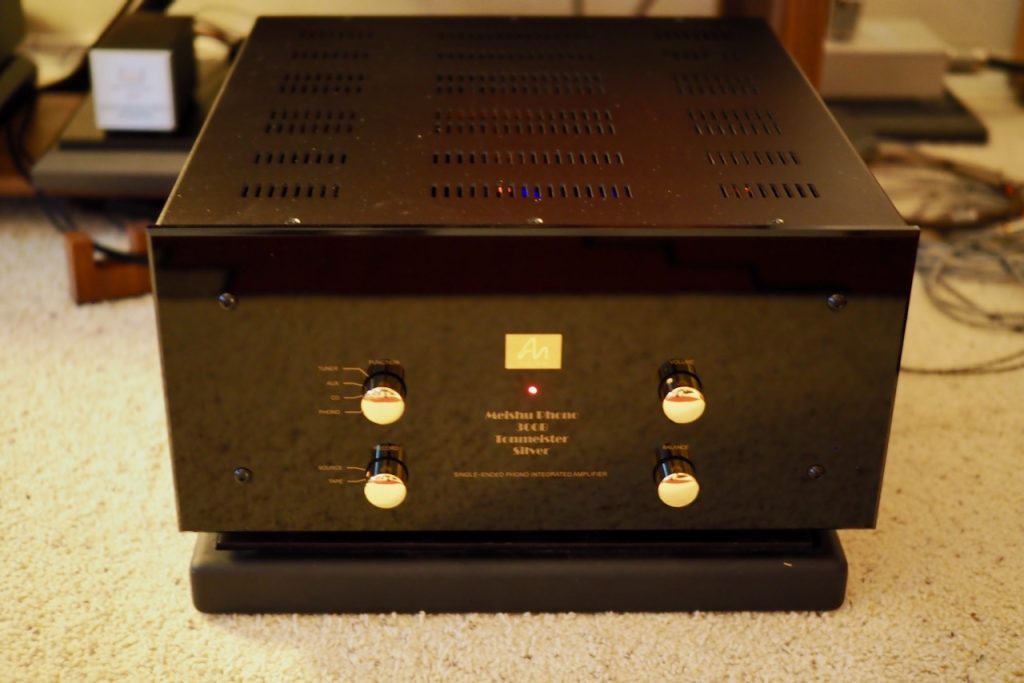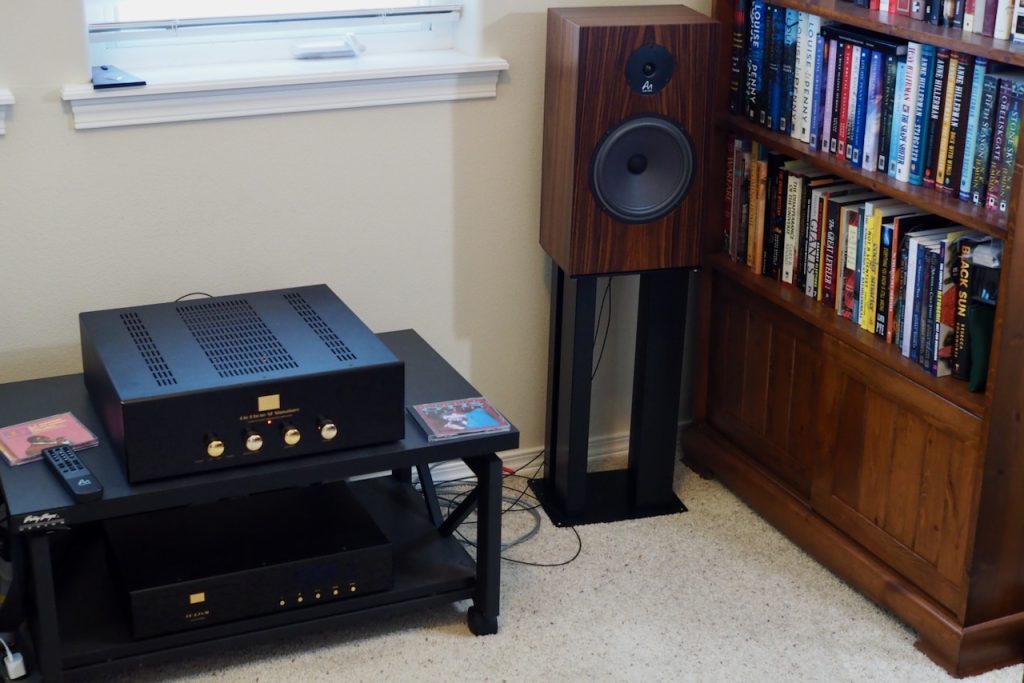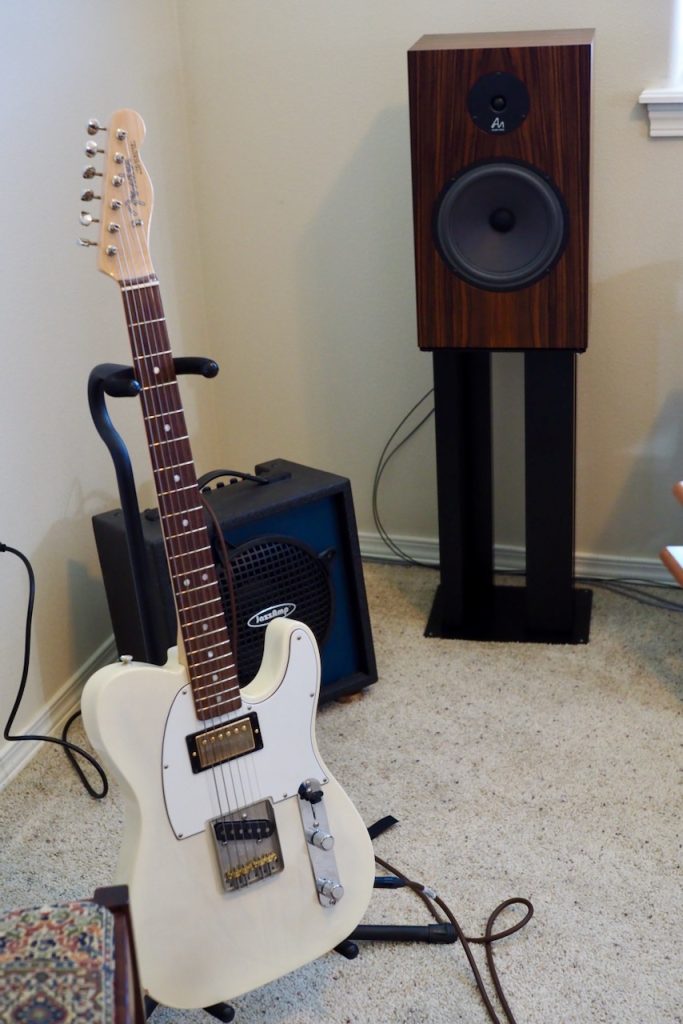Greetings friends, I hope you are doing well!
I've been doing well, except for the Summer cold I caught a few weeks back. Knocked me down for about a week, but all better now.
Summer is definitely here, and the temperatures are soaring, with yesterday hitting 104F! I actually went out for a bicycle ride in the morning before it got too hot during the peak heat period around 4PM.
Audio Note (UK)
I've been having a blast listening to the Audio Note (UK) kit I've got here in the ongoing survey I've been doing.

The Mighty Meishu Tonmeister!
Right now I'm working on the Positive Feedback feature review of the Audio Note (UK) Meishu Phono Silver Tonmeister 300B SET integrated amplifier.
The 'Mighty Meishu Tonmeister' is what I've started calling it, and it's one heck of an integrated amp!
The new Audio Note (UK) Meishu Phono Silver Tonmeister 300B integrated amplifier is an integrated amplifier that utilizes a pure Class A, zero negative feedback, directly-heated, single-ended-triode output stage, with valve rectification.
But wait ... there's a lot more cool things about the Mighty Meishu Tonmeister's design than even the above, which are very notable even in their own right.
My take on the design of the new Audio Note (UK) Meishu Phono Silver Tonmeister 300B SET integrated amplifier, is that it is a 300B SET integrated amplifier with a design and level of performance approaching that of the much more expensive Jinro, Tomei, and Ongaku 211 SET based integrated amplifiers, but at a much more accessible price point for audio enthusiasts.
For those of us who have to keep an eye on costs that's really good news. The Mighty Meishu Tonmeister is not cheap at $18K USD and change, but there is a lot of value in the design that I'm not sure there's a full appreciation of yet among audio enthusiasts.
Just for a few teasers, let me add that from a design perspective the Mighty Meishu Tonmeister uses a classic phono stage that is zero-feedback, single-ended, and with a CR passive RIAA equalization network. Nice, and definitely one of my favorite approaches to a phono stage.
The Mighty Meishu Tonmeister has an important new input and driver stage similar to that found in the top-of-the line Jinro, Tomei, and Ongaku 211 SET integrated amplifiers. Cool eh?
The Mighty Meishu Tonmeister uses a three-stage transformer coupled signal flow similar to that in the Jinro, Tomei and Ongaku 211 SET integrated amplifiers. More cool!
The Mighty Meishu Tonmeister has new über-performance interstage and output transformers designed by Andy Grove specifically for the new Meishu.
Is there anything that I don't like about the Mighty Meishu Tonmeister? It's an amazing integrated amplifier, and the only thing that I don't like about it is that its not mine.
It checks all the boxes that I love about high-performance integrated amplifiers. Exquisite build quality, value, superb performance, low-component count, and a great phono stage.

Completed Audio Note (UK) audio system with AN-K/Spe loudspeakers.
In my guitar practice room / office, I've got a complete Audio Note (UK) system setup that I'm listening to on a daily basis.
You've already read my Positive Feedback feature reviews of the Audio Note (UK) CD 2.1x/II Level Two Red Book CD player HERE), and the Audio Note (UK) Oto Phono SE Signature integrated amplifier (HERE), so you know I really love both of those components.
One thing I can say about Audio Note (UK) components is that they always get the music right, presenting it as full of life and emotion, and the Audio Note (UK) AN-L/Spe loudspeakers (HERE) are no exception. They are remarkable music transducers.

Audio Note (UK) AN-K/SPe loudspeakers.
The owner's manual (HERE) says this about running-in the Audio Note (UK) AN-K/SPe loudspeakers:
"While we fully expect your AN-K loudspeakers to produce beautiful music, they may not do so from the first moment out of the box. Don’t be alarmed; this is perfectly normal."
"Dynamic loudspeakers have a running in period, during which time the drive units “loosen up”. During this period, the sound may be somewhat dry, bright and constricted. As the suspension and cone materials of both drive units “softens up”, the fullness of the bass and the smoothness of the treble will start to emerge and the true sound of the AN-K will be revealed."
I liked the Audio Note (UK) AN-K/SPe loudspeakers the first time I heard them, and they've been running in since then to get to their recommended run-in time of 100 hours.
In this system context, AN-K/SPe loudspeakers did sound a little bit - but only a little bit - "... dry, bright and constricted ..." when I first started listening to them.
They do go through a rather remarkable transformation at around the 100 hour mark, and become richer, warmer, and very, very, well-balanced across the frequency range. I really like what I am hearing from them.
By the way, one of my favorite audio writers, Herb Reichert, told me that the Audio Note (UK) AN-K loudspeakers are among his all-time favorite loudspeakers. I definitely understand Herb's high opinion of the AN-K's, they really are great loudspeakers.
I've been doing a lot of listening with the AN-K/SPe loudspeakers as I practice my guitar. I'm in the process of sharpening my listening skills at picking out the key of the music by ear, then figuring out the chord progressions used in songs, and then learning how to play the songs on my guitars.
The AN-K/SPe loudspeakers are so good at relaying the musical content of recordings that it helps me in figuring those kind of musical things out.

Funk-Soul!
The music I've been listening to for sharpening my listening skills are funk-soul classics, like Wilson Pickett's In The Midnight Hour, Fred Parris' In the Still of the Night, Ed Townsend's For Your Love, Eddie Floyd's Knock on Wood, Otis Redding's These Arms of Mine, and J.J. Jackson's But It's Alright, for example.
Those songs are great places to start with ear training because they have relatively simple structures and chord progressions.
However, its obvious that the recording quality of those funk-soul albums were not even close to being in the same league as the Bill Evans Riverside recordings, for example, and in fact the recording quality was rather marginal for the most part.
However, this is classic funk-soul music that deserves to be heard and enjoyed, and the Audio Note (UK) AN-K/SPe loudspeakers make them sound better than they have any right to given their recording quality.
It's quite startling to take a recording that is not so good quality-wise, but great musically, and then listen to it with the Audio Note (UK) AN-K/SPe loudspeakers, and have it sound really, really, good, full of life, and emotionally engaging.
I've got to ask Peter Qvortrup more about his voicing strategy for components to figure out how they make this sort of magic trick happen. It's not done by reducing resolution, or adding obvious colorations that 'mask' recording flaws, I can tell you for sure. How? Because they are very resolving, very articulate, very dynamic, very 'present', and very 'real' sounding in musical terms.
That resolution and articulation makes it much easier on me when I'm trying to pick out things by ear from the recorded music to play on my guitars, and the fact that the AN-K/SPe loudspeakers are forgiving of recordings of lesser quality makes for a lot of fun while listening.
This full Audio Note (UK) system may be the best system I've ever encountered for those who want to explore all kinds of music, hear it at its musical best, and not break the bank in buying a system. I'm impressed.
You know what? I'm not a funk or soul listener. At least I didn't used to be, but this full Audio Note (UK) system with the AN-K/SPe loudspeakers has converted me, and I'm really enjoying listening to and learning how to play this music on my guitar.
You might be surprised to find that you really like the styles of music that you've never listened to before, when listening to them with a full Audio Note (UK) system like this one.
Ok, let me back up and give you a basic introduction to the AN-K/SPe loudspeakers. The version of the AN-K loudspeakers that I have here are the AN-K/SPe loudspeakers which are towards the upper end of the AN-K product line.
The AN-K loudspeakers are "... a compact ‘book shelf’ design, using two drive units per cabinet to cover a very wide frequency response ... (are) relatively efficient and offers the amplifier an easy ‘load’, making it highly suitable for our range of superior quality, low powered valve amplifiers."
The AN-K/SPe version has "(a) 3/4” tweeter & 8” paper bass driver with copper voice coils, 90 dB efficient, AN-SPe internal silver cable, internal crossover, copper inductors, Finnish birch ply cabinet, and is finished in real wood veneers."
These AN-K/SPe loudspeakers are really nice loudspeakers. Oh, and before I forget, they sit atop AN-K loudspeaker stands (HERE).
Much more to come about the AN-K/SPe loudspeakers!

My vintage Altec A5s based audio-visual system with the Mighty Meishu Tonmeister.
300B amplification and Altec A5 Voice of the Theatre loudspeakers were a classic combination used in many small to medium sized movie theaters in the USA back in the day, and today they make for an incredible combination in my audio-visual system.
With the 300B Mighty Meishu Tonmeister I was blown away with how good my big Altec A5 Voice of the Theatre loudspeakers sounded when playing movies. The Meishu was very transparent, very dynamic, very resolving, very articulate, very spacious sounding, and made every movie I watched an extremely involving experience.
I love the Meishu Tonmeister and Altec A5 Voice of the Theatre loudspeakers, a very addictive combination!
I'd really been enjoying listening to the Mighty Meishu Tonmeister in my vintage Altec A5 Voice of the Theatre loudspeakers based audio-visual system, and then I moved the Meishu into my main music system in preparation for its Positive Feedback feature review.
Pass Labs and First Watt
I got the idea that this was the perfect opportunity for me to rotate the Pass Labs and First Watt kit I have here through my audio-visual system, which I haven't had the opportunity to do yet.
I've been wanting to get some more listening time in on the impressive Pass Labs push-pull XA25 stereo amplifier (review HERE), and the single-ended First Watt SIT-3 (review HERE) and F8 (review HERE) stereo amplifiers.

Pass Labs XA25 amplifier, XP-12 preamp, and XP-17 phono preamp with vintage Altec A5 VoTs.
Understandably, when someone refers to push-pull or single-ended amplifiers a lot of us think of classic vacuum tube amplifiers.
However, its not only vacuum tube amplifiers that carry the push-pull and single-ended designations, but also the superb sounding solid-state designs of Nelson Pass for Pass Labs and First Watt.
To start my audio-visual adventure, I installed the Pass Labs XP-12 line-level preamplifier (review HERE), the Pass Labs XP-17 phono preamplifier (review HERE), and the Pass Labs push-pull XA25 stereo amplifier (review HERE), into my audio-visual system.

Pass Labs XP-12 line-level preamplifier, the Pass Labs XP-17 phono preamplifier, and the Pass Labs push-pull XA25 stereo amplifier.
I've been a big fan of Nelson's solid-state designs forever, it seems. My first Nelson Pass designed amplifier was the Adcom GFA-555 way back in the 1980s, to be followed by the Pass Labs Aleph 3 in 1997.
I've been enjoying both vacuum tube and solid-state amplification for decades, and they both have charms.

The push-pull vintage McIntosh MC30 monaural amplifiers.
Among my all-time favorite push-pull amplifiers are the classic McIntosh MC30 monaural amplifiers (above), which made their debut in 1954, and now 68 years later can still give the best of the best in push-pull amplifiers a run for their money.
Well, except for the the Pass Labs push-pull XA25 stereo amplifier, that is. The XA25 is a remarkable amplifier, and if I blindfolded you for a listening session, I'll bet you would think it was a vacuum tube amplifier.
The XA25 is rich, musically natural, articulate, dynamic, resolving, and dead quiet even on my highly-sensitive Altec A5 Voice of the Theatre loudspeakers.
The XA25 sounds like a truly superb push-pull valve amplifier, but even better, as it is more extended at the frequency extremes, more reliable, and there's no ongoing maintenance costs for replacing tubes.
In future posts I'll tell you more about how the push-pull XA25 stereo amplifier compares to Nelson's singled-ended SIT-3 and F8 power amplifiers, so stay tuned for that.
Here's the reality: these days both vacuum tube and solid-state amplification is really, really, good. Both amplifications devices - vacuum tubes and solid-state devices - have their own unique characters, and certain enthusiasts will likely prefer one over the other.
Personally, I really like both, and I'm just thankful that I have such good audio kit here to tell you about, both those based on vacuum tubes and solid-state devices.
I live with both on a daily basis, and I could live with either as my 'forever' audio kit.
Pacific Audio Fest

The Pacific Audio Fest is coming up soon, on Friday to Sunday, July 29-31, in Seattle (website HERE).
I don't venture out for audio shows very often any more, but I'm really looking forward to going to the Pacific Audio Fest.
I hope to see you there!
I've written two updates about the Pacific Audio Fest that you should read:
Seven Tips for Getting the Most Out of Your Trip to the Pacific Audio Fest in 2022 - Part 1! (HERE)
Tips for Getting the Most Out of Your Trip to the Pacific Audio Fest 2022 - Part 2! (HERE)
As always, thanks for stopping by, and may the tone be with you!





























